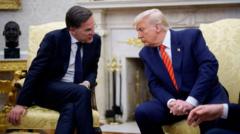Is NATO's Summit All About Trump Despite 32 Nations?

NATO Summits: A Balancing Act of Diplomacy and Defense
The North Atlantic Treaty Organization (NATO) summits serve as pivotal moments in global politics, where member nations converge to discuss strategic defense initiatives and address pressing geopolitical concerns. With the world increasingly polarized, these gatherings have become arenas for demonstrating unity, negotiating power dynamics, and responding to emerging threats. The upcoming NATO summit in The Hague, under the leadership of Secretary General Mark Rutte, promises to be no exception, especially given the complex dynamics introduced by U.S. President Donald Trump and the evolving security landscape in Europe.
The Prelude to the Summit: Setting the Stage
The anticipation surrounding NATO summits often resembles a carefully choreographed performance, where every participant knows their lines, yet the underlying tensions remain palpable. This year’s summit is particularly significant, as it unfolds against the backdrop of heightened security concerns stemming from Russia's aggressive posture, notably its invasion of Ukraine. The summit is scheduled to take place over two days at the World Forum in The Hague, with discussions expected to be succinct and focused, largely to accommodate President Trump's preferences.
The Menu of Discussions
When it comes to the agenda, the primary dish on the table is a commitment to increased defense spending by European allies, a demand that President Trump has consistently reiterated. During his tenure, Trump has critiqued NATO countries for not meeting their defense spending obligations, which he argues places an undue financial burden on the United States. At this summit, European leaders are expected to deliver on this front, albeit with a compromise that may mask deeper divisions.
- The summit statement is anticipated to be concise, with reports suggesting a reduction to just five paragraphs, likely to simplify messaging and avoid contentious debates.
- Discussions are expected to last around three hours, raising questions about the depth of dialogue on critical issues such as trade, relations with Russia, and the ongoing conflict in the Middle East.
- Security measures for this summit are unprecedented, with a budget exceeding €183.4 million, reflecting the seriousness with which these discussions are approached.
The Complex Dynamics of Defense Spending
One of the most contentious topics among NATO members has been the commitment to defense spending. The existing guideline that each member should allocate 2% of their GDP to defense has been a point of contention for years. In light of President Trump's demands and the evolving security climate, Secretary General Rutte has proposed an increase to 3.5% of GDP for core defense spending, with an additional 1.5% earmarked for defense-related expenditures.
The Challenges Ahead
While some nations, particularly those bordering Russia—such as Poland, Estonia, and Lithuania—are already moving towards these spending targets, many others face significant hurdles. The new spending benchmarks have raised concerns about feasibility and political will. Several nations have struggled to meet even the original 2% target, and now the prospect of reaching 5% within a defined timeframe appears daunting.
This pressure to increase defense spending is not solely a product of Trump’s influence; it is also a reaction to the geopolitical reality posed by Russia's actions. The invasion of Ukraine has prompted a reevaluation of NATO’s strategic priorities, which is reflected in member states’ military spending plans. However, the vagueness surrounding what constitutes "defense-related expenditure" could lead to misinterpretation and creative accounting rather than genuine increases in defense capabilities.
The Geopolitical Landscape: A Divided Alliance
The NATO summit also serves as a stage for showcasing the differences among member nations, particularly in their approaches to Russia and the war in Ukraine. While European allies view the security of Ukraine as integral to their own safety, the current U.S. administration has demonstrated a more ambivalent stance. This schism could complicate discussions and lead to a diluted consensus on future strategies.
The Russian Factor
Secretary General Rutte has indicated that NATO must significantly enhance its defense capabilities, calling for a 400% increase in air and missile defenses, as well as substantial boosts in armored vehicles and artillery. Yet, specific discussions regarding strategies to counter Russian aggression will likely be downplayed during the summit, as leaders aim to avoid further exacerbation of tensions with Trump, who has occasionally favored dialogue with Russian President Vladimir Putin over collective action.
The Future of NATO: Navigating Uncertain Waters
The upcoming NATO summit is set to be a critical moment for the alliance, as it grapples with the dual pressures of external threats and internal disunity. The effectiveness of NATO in the face of these challenges will depend on the ability of member states to look beyond their immediate interests and foster a unified approach to defense and security.
Long-term Goals and Strategic Vision
In the long run, NATO's strategy must evolve to address the changing nature of warfare and the multifaceted threats facing its member states. This includes not only military readiness but also the integration of cyber defense, intelligence sharing, and cooperative security arrangements with non-member nations. The summit will likely set the tone for these long-term objectives and the alliance’s strategic vision moving forward.
Conclusion: A Call for Unity in Diversity
As NATO leaders prepare for their crucial summit in The Hague, the stakes have never been higher. The need for a united front is paramount, especially in the face of rising geopolitical tensions and the unpredictable nature of global politics. While the agenda may be streamlined and contentious issues sidelined, the underlying divisions will remain a challenge that NATO must confront head-on. The success of this summit will hinge on the ability of member states to navigate their differences and work towards a coherent strategy for collective defense.
FAQs
What is the primary focus of the upcoming NATO summit?
The summit primarily focuses on increasing defense spending commitments among European allies, responding to heightened security threats, particularly from Russia, and fostering unity among member states.
How has President Trump's stance influenced NATO discussions?
President Trump's insistence on higher defense spending has pressured European allies to commit to increased military expenditures, reshaping NATO's spending agenda. His approach has also highlighted existing divisions within the alliance regarding foreign policy and security priorities.
What are the potential challenges in meeting the new defense spending targets?
Many NATO members have struggled to meet the previous 2% GDP defense spending guideline, making the proposed increase to 5% seem ambitious. Political will, economic constraints, and differing national priorities pose significant challenges.
How does the war in Ukraine impact NATO's strategy?
The war in Ukraine has prompted NATO to reassess its defense strategies and capabilities, emphasizing the need for increased military preparedness and a unified response to Russian aggression.
As NATO navigates the complexities of global politics, will it emerge as a stronger alliance, or will the divisions deepen? The world watches with bated breath. #NATO #DefenseSpending #GlobalSecurity
Published: 2025-06-20 23:10:15 | Category: technology



